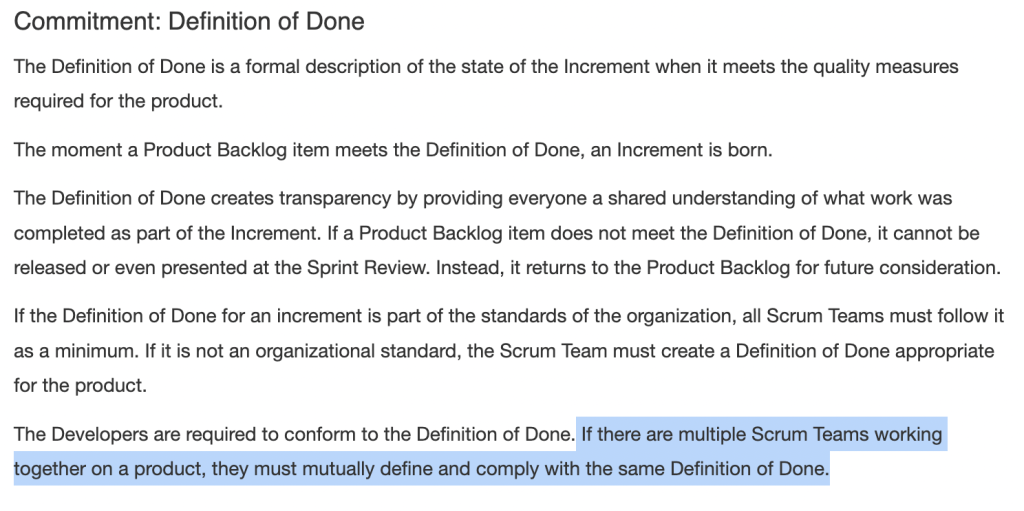More Scrum Questions:
The integration of increments from multiple Scrum teams working on the same product
The integration of increments from multiple Scrum Teams working on the same product is a key aspect of scaled Scrum. The Scrum Guide, which is the official guide to Scrum written by the creators of Scrum, provides guidance on this.
The Developers are required to conform to the Definition of Done. If there are multiple Scrum Teams working together on a product, they must mutually define and comply with the same Definition of Done
From the Scrum Guide section “Commitment: Definition of Done”
So, the Scrum Guide doesn’t prescribe specific practices for how multiple Scrum Teams should integrate their work. However, it does emphasize the importance of creating a “Done” Increment in each Sprint, and this Increment should be in a potentially releasable state.

Step by Step Analysis: How to Handle Increments From Multiple Teams?
Let’s discuss the 4 different statements about whether or not increments from multiple teams working on the same product should be integrated every Sprint.
A. No, that is far too hard and must be done in a hardening Sprint.
B. Yes, otherwise the Product Owners (and stakeholders) may not be able to accurately inspect what is done.
C. Yes, but only for Scrum Teams whose work has dependencies.
D. No, each Scrum Team stands alone.
A. “No, that is far too hard and must be done in a hardening Sprint.”
Delaying integration until a hardening Sprint may introduce risks and so this doesn’t adhere to Scrum principles !
What is a hardening sprint? A hardening sprint, is a sprint which some Agile teams use to focus solely on integration, testing, and fixing bugs before a release. However, this type of sprint is not mention in the Scrum Guide and also contradicts the principles of Scrum that promotes addressing these activities within each Sprint in the process to create a product increment that is always in a ready-to-release state.
B. “Yes, otherwise the POs (and stakeholders) may not be able to accurately inspect what is done.”
Yes, increments from multiple teams working on the same product should be integrated every Sprint. This option highlights the importance of integration for accurate inspection by Product Owners and stakeholders. ✅. (ALIGNED TO SCRUM PRINCIPLES)
Letting each team release its increment is the main Goal of each Sprint and allows Product Owners and stakeholders to accurately inspect what has been done. Integrating the increments every Sprint aligns with the Scrum principles NOT ONLY for continuous integration purposes but because it allows for early detection of integration issues ensuring feedback is given by stakeholders and PO. This solution also increases the chances to deliver value to the user leading to a more cohesive and higher-quality product.
C. Yes, but only for Scrum Teams whose work has dependencies.
This statement is not entirely correct within the context of Scrum. While teams with dependencies certainly need to integrate their work, all Scrum Teams should integrate their increments every Sprint. Specifically, if an increment is not going to affect another team, there is no reason to delay its integration.
D. “No, each Scrum Team stands alone.”
This option suggests a more isolated approach for each Scrum Team and doesn’t adhere to Scrum principles. Similar to what has been said for answers A and C, in Scrum, when multiple teams work on the same product, integrating their work every Sprint is essential.
Conclusion
When many Scrum Teams are working on the same product, should all of their Increments be integrated every Sprint?
Yes, otherwise the Product Owners (and stakeholders) may not be able to accurately inspect what is done.
- Accurate Inspection: It allows Product Owners and stakeholders to accurately inspect what has been done, ensuring that feedback can be given in a timely manner.
- Early Detection of Issues: Continuous integration reduces the risk of last-minute problems and aligns with Scrum principles of ensuring that the product increment is always in a potentially shippable state.
- Delivering Value: Regular integration with feedback loops increases the chances of delivering value to the user by ensuring a cohesive and high-quality product.
You Might Like More…
- Which Scrum Role is Responsible to do all the Work Required to Turn Product Backlog in Potentially Releasable Items?
- What Happens If Scrum Teams Become Too Large?
- Understanding the Role of Product Manager vs. Product Owner
- Product Management Terms
REFERENCES
Scrum Guide, 2021

